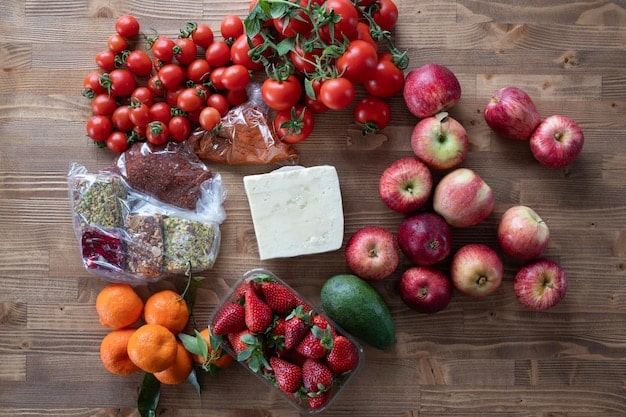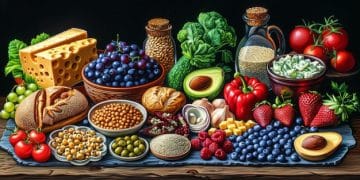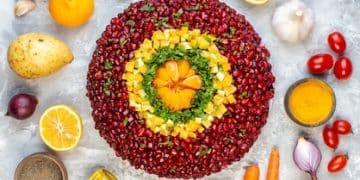Decoding Food Labels: Your 2025 Guide to Healthier Choices

Navigating food labels in 2025 is essential for making informed dietary decisions, empowering consumers to understand nutritional content, ingredient lists, and health claims to foster healthier eating habits and promote overall well-being.
In an increasingly conscious world, understanding what’s truly in our food has become paramount. This comprehensive guide on Decoding Food Labels: A Step-by-Step Guide to Making Healthier Choices in 2025 aims to empower you with the knowledge to make informed decisions for your health and well-being.
The Evolving Landscape of Food Labeling
Food labeling has undergone significant changes over the years, continually adapting to new scientific discoveries, consumer demands, and regulatory updates. What was once basic nutritional information has evolved into a complex system designed to provide a deeper insight into the content and origin of our food products. For 2025, several key trends and stricter regulations are shaping how food labels are presented and interpreted.
Key Regulatory Shifts in 2025 Shaping Food Labels
As we move into 2025, governmental bodies and health organizations are pushing for greater transparency. New regulations focus on clearer allergen declarations, more precise nutrient profiling, and standardized definitions for terms like “natural” or “organic.” These changes are intended to reduce consumer confusion and prevent misleading claims, ensuring that the information provided is both accurate and easily digestible for the average shopper. Understanding these shifts is the first step in effective label decoding.
- Allergen clarity: Enhanced visibility for common allergens.
- Nutrient profiling: Standardized methods for evaluating nutritional value.
- Claim definitions: Stricter criteria for “natural,” “healthy,” and “organic” labels.
- Front-of-pack labeling: Simplified, at-a-glance health indicators.
The push for clearer labeling is a direct response to a growing public demand for accountability from food manufacturers. Consumers are no longer content with vague promises; they want facts. This increased scrutiny means that manufacturers must be more diligent in their labeling practices, and consumers must be more adept at interpreting the wealth of information provided. The goal is to bridge the gap between what is advertised and what is actually consumed, fostering a more trustworthy relationship between industry and individual.
Furthermore, technological advancements are playing a role, with some labels now incorporating QR codes linking to extended information, including sourcing details, sustainability practices, and even recipe suggestions. This digital augmentation of physical labels represents a leap forward in consumer empowerment, allowing for a deeper dive into product specifics for those who seek it. It’s a dynamic environment, one that requires continuous learning and adaptation from both producers and consumers alike.
Deconstructing the Nutrition Facts Panel
The Nutrition Facts panel remains the cornerstone of food labeling, providing a standardized format for understanding a product’s nutritional breakdown. While its core structure has endured, nuances in serving sizes, updated daily values, and new mandatory declarations require a fresh look for 2025. This section guides you through each critical component, enabling you to extract maximum value from this essential dietary tool.
Understanding Serving Size and Servings Per Container
Often overlooked, the serving size is the foundation upon which all other nutritional values are built. It indicates the typical amount of food consumed at one time and, critically, how many servings are in the entire package. It’s easy to inadvertently consume multiple servings, thereby multiplying the stated calorie and nutrient intake. Always check the serving size first and adjust your calculations accordingly.
- Serving size: Basis for all nutritional values listed.
- Servings per container: Total number of servings in the package.
- Portion awareness: Crucial for accurate calorie and nutrient intake.
- Realistic consumption: Reflects amounts typically eaten rather than arbitrarily set.
This initial step is paramount because misinterpreting the serving size can lead to significant discrepancies between perceived and actual consumption, impacting dietary goals. For instance, a small bag of chips might contain two servings, meaning that eating the entire bag doubles all the listed nutrient values. This simple check can drastically alter one’s understanding of a product’s caloric density and overall nutritional contribution.
Navigating Calories and Macronutrients
Calories provide the energy content, while macronutrients (fats, carbohydrates, and protein) are the building blocks of our diet. Pay attention to total calories, but also differentiate between types of fats (saturated, trans), carbohydrates (total carbs, dietary fiber, added sugars), and protein content. The “added sugars” line is particularly important as it distinguishes naturally occurring sugars from those intentionally added during processing, offering a clearer picture of a product’s sugar profile.
For fats, minimizing saturated and avoiding trans fats is a common health recommendation. Trans fats, often a byproduct of partial hydrogenation, are particularly insidious for cardiovascular health. Understanding the carbohydrate breakdown is also key, as dietary fiber contributes to digestive health and blood sugar regulation, while excessive added sugars can contribute to various health issues. Protein, essential for muscle repair and satiety, should also be considered in your daily intake. The interplay of these macronutrients significantly influences a food’s impact on your energy levels and overall health. Furthermore, 2025 labels increasingly emphasize healthier fat profiles, promoting unsaturated fats over saturated ones. This detailed breakdown empowers consumers to choose products align with heart-healthy guidelines and weight management strategies.
Deciphering Micronutrients and Daily Values (% DV)
Vitamins and minerals are micronutrients vital for proper bodily function. The % Daily Value (% DV) column indicates how much a single serving contributes to your recommended daily intake of each nutrient. A % DV of 20% or more is considered high, while 5% or less is considered low. Use this as a quick guide to identify foods rich in beneficial nutrients (like fiber, vitamins, minerals) and those high in less desirable components (like sodium, saturated fat, added sugars).
The % DV is a powerful tool for comparing products and understanding nutrient density. For example, if you’re looking to increase your fiber intake, you can quickly scan labels for products with a high fiber % DV. Conversely, if you’re managing sodium intake, you’d look for low % DV for sodium. This comparative analysis helps in balancing your overall diet, ensuring you meet your nutritional needs without excess. It’s a quick, at-a-glance assessment that transforms complex nutritional data into actionable insights for daily meal planning. This approach streamlines decision-making, allowing for efficient shopping that prioritizes health objectives.
Unraveling the Ingredient List
Beyond the numbers on the Nutrition Facts panel, the ingredient list provides the narrative of your food. Ingredients are listed in descending order by weight, meaning the first few ingredients are the most abundant in the product. This section explores how to meticulously read and interpret this crucial list, moving beyond surface-level understanding to truly grasp what you’re consuming.
Prioritizing Whole, Recognizable Ingredients
A key principle in healthy eating is opting for foods with ingredient lists that are short and contain items you recognize. Products heavy in whole foods—fruits, vegetables, whole grains, lean proteins—are generally more nutrient-dense and less processed. The longer the list, and the more unpronounceable the ingredients, the higher the likelihood of it being a highly processed food with additives.
- Short lists: Indicate less processing and fewer additives.
- Recognizable names: Prioritize ingredients you know are real foods.
- Whole food emphasis: Lean towards items with fruits, vegetables, whole grains.
- “Unpronounceable” alert: A sign of potential artificial additives or complex chemicals.
This simple rule of thumb empowers consumers to quickly assess the quality of a product without delving into complex chemical names. If you need a scientific dictionary to understand the ingredients, it’s a good indication that the food has undergone significant industrial transformation. Conversely, a list predominantly featuring single-ingredient items or common culinary components suggests a more natural and wholesome composition, closer to its original state rather than a concoction of synthesized components. This practical approach demystifies food choices, making healthy eating more intuitive.
Identifying Common Additives and Preservatives
Many processed foods contain a variety of additives, including artificial colors, flavors, sweeteners, and preservatives. While many are deemed safe in small quantities, some individuals may experience adverse reactions, and long-term effects of consuming multiple additives are still being studied. Be mindful of ingredients like high-fructose corn syrup, artificial colors (e.g., Red 40, Yellow 5), artificial sweeteners (e.g., aspartame, sucralose), and various preservatives (e.g., BHA, BHT).
Understanding these additives helps you make informed choices, especially if you or a family member has sensitivities. For instance, trans fats can appear under names like “partially hydrogenated oil,” a red flag for cardiovascular health. Similarly, hidden sugar sources can be disguised under multiple names such as dextrose, maltose, or corn syrup solids. By knowing these aliases, you can systematically reduce your intake of undesirable components, moving towards a cleaner, less processed diet. This vigilance empowers consumers to proactively manage their health, mitigating risks associated with certain food constituents.
Spotting Hidden Sugars and Unhealthy Fats
Sugar goes by many names—at least 60, in fact. Look for terms like corn syrup, high-fructose corn syrup, dextrose, sucrose, maltose, molasses, fruit juice concentrate, and anything ending in “-ose.” Similarly, unhealthy fats can be masked. Beyond “partially hydrogenated oil” (trans fats), be wary of excessive amounts of palm oil, coconut oil, and other highly saturated fats if dietary fat intake is a concern. The less refined and diversified your fat sources, the better.
The ubiquity of hidden sugars makes it challenging for average consumers to track their intake effectively. Manufacturers often use multiple types of sugar to keep any single sugar from appearing as the first ingredient, a tactic known as “sugar splitting.” This practice, while legal, can contribute to overconsumption of sugars. Similarly, understanding the difference between healthy fats (like those found in avocados or olive oil) and less healthy ones (like partially hydrogenated oils) is crucial for heart health. Becoming adept at identifying these hidden ingredients is a powerful step towards regaining control over your diet and making truly healthier choices.
Navigating Health Claims and Marketing Hype
Food labels are not just about nutrition and ingredients; they also serve as powerful marketing tools. Health claims, often prominently displayed on the front of packaging, can be alluring but require careful scrutiny. In 2025, while regulations are tightening, understanding the nuances of these claims remains essential to avoid falling for marketing hype. This section empowers you to critically evaluate these statements, separating genuine health benefits from persuasive ploys.
Distinguishing “Free From” and “Low In” Claims
Terms like “sugar-free,” “fat-free,” “gluten-free,” “low sodium,” or “light” are common. While these claims can indicate a reduction in a specific nutrient, they do not automatically equate to a healthy product. For example, “fat-free” often means added sugar or artificial sweeteners to compensate for flavor, while “gluten-free” products can still be high in calories, sugar, or unhealthy fats. Always check the Nutrition Facts panel and ingredient list to get the full picture.
- “Free From”: Indicates absence of a specific ingredient (e.g., sugar, gluten).
- “Low In”: Signifies reduced levels of a nutrient (e.g., sodium, fat).
- Holistic view: Essential to check other nutritional aspects like calories, sugar, and fat content.
- No automatic health guarantee: These claims don’t make a product inherently healthy.
The “free from” and “low in” claims are marketing strategies designed to appeal to specific dietary concerns, but they rarely tell the whole story. A “low-fat” yogurt filled with artificial sweeteners might not be a healthier choice than a full-fat version with natural ingredients and less sugar. The key is to look beyond the bold claims and scrutinize the actual nutritional composition. This critical step ensures that you’re not swapping one undesirable component for another. It’s about understanding the trade-offs and making choices that align with your overall health philosophy rather than just targeting a single nutrient reduction.
Understanding “Natural,” “Organic,” and “Whole Grain” Labels
These terms carry significant weight with consumers, implying healthier or more environmentally friendly options. “Natural” often has a vague legal definition and might simply mean the product contains no artificial ingredients, but it can still be highly processed. “Organic” is more regulated, implying no synthetic pesticides, fertilizers, GMOs, or antibiotics, but it doesn’t guarantee a low-calorie or low-sugar product. “Whole grain” indicates the product retains all parts of the grain, making it nutritionally superior to refined grains, but always look for “100% whole grain” as the first ingredient.
The vagueness around “natural” can be particularly misleading. While it sounds appealing, it offers little guarantee about the product’s nutritional quality or processing level. “Organic” certification provides a more stringent framework, but it’s important to remember that organic cookies are still cookies. The pursuit of “whole grain” products is generally beneficial, given the fiber and nutrient content. However, distinguishing between “multigrain” (which might not be whole grain) and “whole grain” is crucial. Look for the “Whole Grain Stamp” if available, a reliable indicator of genuine whole grain content. These distinctions empower you to invest in claims that truly align with health and sustainability rather than just feel-good marketing. Educating oneself on these nuances is crucial to making truly informed choices in 2025 and beyond.
Beware of Health Halo Effects and Buzzwords
Certain ingredients or terms can create a “health halo” around a product, making it seem healthier than it is. “Gluten-free,” “plant-based,” “probiotic-rich,” or “superfood” can be buzzwords that distract from high sugar, unhealthy fats, or excessive processing. For example, a “gluten-free” cookie may have more sugar and fat than its gluten-containing counterpart. Always critically assess the product’s entire nutritional profile rather than being swayed by a single appealing claim or ingredient.
The “health halo” effect is potent and often preys on consumer desires for quick fixes or trending diets. While plant-based diets are laudable, a highly processed vegan burger might be nutritionally inferior to a piece of grilled chicken. Similarly, a product boasting “probiotics” but loaded with artificial flavors and colors might undermine any potential gut health benefits. The ability to look past these buzzwords and evaluate the holistic nutritional value of a product is a hallmark of an empowered consumer. It requires a discerning eye and a commitment to data over marketing, ensuring that choices are founded on sound nutritional principles, not just appealing claims.
Practical Strategies for Healthier Choices in 2025
Decoding food labels isn’t just an academic exercise; it’s a practical skill that translates directly into healthier eating habits. In 2025, with an abundance of choices and evolving regulations, having a clear strategy for applying label knowledge is more important than ever. This section provides actionable advice, empowering you to integrate label literacy into your daily decision-making processes for a truly healthier lifestyle.
Comparing Products and Making Informed Swaps
One of the most effective ways to use label information is for product comparison. When faced with multiple options (e.g., different brands of yogurt, bread, or cereal), take a moment to compare their Nutrition Facts panels and ingredient lists. Look for options with lower added sugars, less saturated fat, higher fiber, and shorter, more recognizable ingredient lists. This direct comparison allows you to make informed swaps that significantly improve your diet quality.
- Side-by-side comparison: Evaluate similar products for nutrient profiles.
- Prioritize: Choose lower added sugars, saturated fats, and sodium.
- Seek: Higher fiber, beneficial vitamins, and minerals.
- Ingredient scrutiny: Opt for shorter, whole-food-based ingredient lists.
This systematic comparison approach is particularly powerful in categories where subtle differences can lead to significant nutritional impacts over time. For instance, comparing different breakfast cereals, one might appear “healthy” on the front but have double the added sugar of another, less advertised option. Similarly, comparing tomato sauces can reveal vast differences in sodium content. These small, consistent improvements accumulate, contributing to substantial long-term health benefits. It’s a pragmatic application of the label-decoding skills, turning knowledge into direct action.
Planning Meals and Snacks Around Label Insights
Once you’re adept at reading labels, integrate this skill into your meal and snack planning. Use the information to construct balanced meals that meet your nutritional needs. For example, if a main dish is low in fiber, you can add a high-fiber side based on its label. If a snack is high in sugar, you can balance it with a protein-rich alternative. This proactive planning helps you manage your overall intake of key nutrients and avoid nutritional gaps or excesses.
Planning not only streamlines grocery shopping but also significantly reduces reactive, less healthy choices. By pre-determining how label insights will guide your food preparation, you create a more intentional and nutritious diet. This forethought enables you to identify where essential nutrients might be lacking in your usual diet and select products that fill those gaps, ensuring a comprehensive and balanced nutritional intake. It transforms label reading from a defensive measure into an offensive strategy for optimal health. This structured approach moves health considerations from an afterthought to a core component of daily routines.
Educating Family Members and Advocating for Clearer Labeling
Your journey into food label literacy can extend beyond personal benefit. Share your knowledge with family members, particularly children, helping them understand the basics of healthy choices. Furthermore, consider advocating for clearer, more comprehensive food labeling regulations. Consumer demand can drive significant changes in the food industry, leading to a healthier food environment for everyone. Engaging with policy makers or supporting organizations that champion food transparency can amplify your impact.
Empowering others with this knowledge creates a ripple effect, fostering healthier communities. Whether it’s teaching a child to spot added sugars or discussing the implications of certain additives with a friend, every conversation contributes to a more informed public. Collective advocacy, even in small ways, puts pressure on manufacturers and regulators to prioritize health over profit, ultimately leading to a food system that is more transparent, accountable, and conducive to well-being. This broader engagement solidifies the importance of label awareness from individual to societal levels.
Looking Ahead: Innovations in Food Labeling for 2025 and Beyond
The landscape of food labeling is not static; it’s a dynamic field continuously evolving with scientific advancements, public health priorities, and technological innovations. As we navigate 2025, several emerging trends promise to further redefine how we interact with and understand our food. These innovations aim to make label decoding even more intuitive, comprehensive, and personalized.
Digital and Interactive Labels
Beyond traditional printed labels, expect to see an increase in digital and interactive labeling. QR codes, NFC (Near Field Communication) tags, and augmented reality (AR) apps can provide instantaneous access to a wealth of supplementary information. This could include detailed sourcing, environmental impact data, more extensive nutritional breakdowns, common allergen information, and even video tutorials on how to prepare the item. These digital layers allow for a more customizable information experience, catering to individual curiosity and specific dietary needs or preferences.
- QR codes: Instant access to detailed product information.
- NFC tags: Tap-to-read data for sustainability and sourcing.
- Augmented reality apps: Visual overlays for real-time nutritional insights.
- Personalized experiences: Tailored information based on user profiles or dietary goals.
The move towards interactive labels represents a significant leap from the static information currently presented. It means that the physical space constraints of packaging will no longer limit the depth of information available. Consumers can quickly scan a product and pull up a robust profile, including certifications, ethical sourcing practices, and even customer reviews. This digital shift supports a more engaged and informed consumer base, ready to dive as deep as they wish into a product’s story. It transforms a simple package into a gateway of comprehensive understanding, fostering a new level of consumer engagement.
Blockchain for Supply Chain Transparency
Blockchain technology, often associated with cryptocurrencies, has immense potential for enhancing food label transparency. By creating an immutable, distributed ledger of a product’s journey from farm to fork, blockchain can verify claims about origin, ethical sourcing, and organic status. This provides an unprecedented level of traceability, ensuring that information on the label accurately reflects the product’s history and mitigating issues like food fraud. For 2025, expect pilot programs and increased industry adoption of blockchain for high-value or highly scrutinized food items.
The application of blockchain in food supply chains addresses a critical consumer demand for trust and authenticity. When a label claims “grass-fed” or “sustainably caught,” blockchain can provide digital proof, offering unparalleled confidence in the product’s provenance. This technology builds a verifiable chain of custody, making it virtually impossible to falsify information without detection. As concerns about food safety contamination and ethical sourcing grow, blockchain offers a robust solution for ensuring label integrity, making it a cornerstone of trust in the future of food. It represents a paradigm shift, enabling consumers to verify claims rather than merely trusting them.
Personalized Nutrition Integration
The ultimate evolution of food labeling might reside in its integration with personalized nutrition. Imagine labels that dynamically display how a product’s nutrients fit into *your* specific dietary needs, based on your health goals, genetic profile, or activity levels. While still largely in research phases, 2025 could see early iterations of this, perhaps through apps that connect with wearable tech or health records to offer real-time dietary guidance during shopping. This level of personalization moves beyond generalized recommendations to highly tailored advice.
The future of food labels is not merely about providing information but about processing that information to be maximally relevant to the individual. For instance, someone managing diabetes might see how a product’s carbohydrate content impacts their blood sugar, while an athlete might see how it contributes to their protein goals. This shift towards hyper-personalized insights transforms labels from generic data panels into bespoke nutritional advisors. While challenges related to privacy and data integration remain, the potential for truly impactful, customized dietary choices is immense, making healthy eating more accessible and effective than ever before.
| Key Point | Brief Description |
|---|---|
| 📊 Understand Nutrition Facts | Master serving sizes, calories, fats, carbs, and daily values for informed choices. |
| 📝 Decode Ingredient Lists | Prioritize whole foods, identify hidden sugars, unhealthy fats, and additives. |
| 🚫 Navigate Health Claims | Look beyond “free from,” “natural,” and “organic” marketing for true nutritional value. |
| 🔮 Future Label Innovations | Anticipate digital tools, blockchain for transparency, and personalized nutrition insights. |
Frequently Asked Questions
▼
Reading food labels in 2025 is essential because it empowers consumers to make informed choices. With evolving regulations and diverse food products, labels provide critical data on nutritional content, ingredients, and potential allergens, enabling individuals to align purchases with their health goals and dietary needs. This prevents misleading claims and fosters greater food transparency.
▼
The most crucial parts to check first are the “Serving Size” and “Servings Per Container.” These determine the actual portion of food being analyzed. Following that, examine total “Calories” and then focus on “Added Sugars” and “Saturated/Trans Fats” in the Nutrition Facts panel, as these often have the most significant impact on health.
▼
To identify hidden sugars, look for ingredients ending in “-ose” (like dextrose, maltose, sucrose), syrups (corn syrup, rice syrup), and concentrates (fruit juice concentrate). Other common names include high-fructose corn syrup, honey, molasses, and evaporated cane juice. Many products use multiple sugar types, so scan for several such terms.
▼
No, “natural” and “organic” labels do not automatically guarantee a healthy product. “Natural” has a broad definition and often only means no artificial ingredients. “Organic” refers to processing and farming methods, ensuring no synthetic pesticides or GMOs, but an organic cookie can still be high in sugar and fat. Always check the full Nutrition Facts panel.
▼
In 2025, expect increasing integration of digital and interactive labels via QR codes or AR apps, offering extended information on sourcing and environmental impact. Blockchain technology may also be used to enhance supply chain transparency and combat food fraud, ensuring greater trust in product claims. Personalization of nutritional data through connected apps is also on the horizon.
Conclusion
Empowering yourself with the ability to decode food labels is a critical step towards achieving and maintaining optimal health in 2025. It moves you from passively consuming what’s offered to proactively choosing what genuinely nourishes your body. By understanding the Nutrition Facts panel, scrutinizing ingredient lists, and wisely navigating health claims, you gain invaluable control over your dietary destiny. This skill not only leads to better personal health outcomes but also contributes to a more informed and health-conscious society, fostering a food environment where transparency and consumer well-being are prioritized.





